Coordinated State Analysis and Differential Regulation of Territorial Spatial Functions in Underdeveloped Regions: A Case Study of Gansu Province, China
Abstract
:1. Introduction
2. Theoretical Framework
3. Materials and Methods
3.1. Study Area
3.2. Data Source and Processing
3.3. Methods
3.3.1. Assessment of Territorial Spatial Function
3.3.2. Measure Model of Coordinated Degree of Territorial Spatial Function
4. Results
4.1. Single Function Evaluation of Territorial Space
4.1.1. Spatial-Temporal Pattern of Production Function
4.1.2. Spatial-Temporal Pattern of Living Function
4.1.3. Spatial-Temporal Pattern of Ecological Function
4.2. Coordinated Degree of Territorial Spatial Function
4.2.1. Type of Coordinated Degree of Territorial Spatial Function
4.2.2. Type of Coordinated Degree of Territorial Spatial Function
4.2.3. Strategies for Adjusting and Controlling Differences in Territorial Space
5. Discussion
5.1. Insights into the Spatial Heterogeneity and the Interaction of Territorial Spatial Function
5.2. Implications for Sustainable Territorial Land Spatial Development and Management
5.3. Uncertainties and Challenges for Further Research
6. Conclusions
Author Contributions
Funding
Institutional Review Board Statement
Informed Consent Statement
Data Availability Statement
Conflicts of Interest
References
- Fang, C. Important progress and prospects of China’s urbanization and urban agglomeration in the past 40 years of reform and opening-up. Econ. Geogr. 2018, 9, 1–9. [Google Scholar]
- Li, Q.; Fang, C.; Wang, S. Suitability evaluation and regulation of rural residential land in Yixing City based on the grey target model. Areal Res. Dev. 2016, 5, 163–169. [Google Scholar]
- Liu, Y.; Wang, J.; Long, H. Analysis of arable land loss and its impact on rural sustainability in Southern Jiangsu Province of China. J. Environ. Manag. 2010, 91, 646–653. [Google Scholar] [CrossRef] [PubMed]
- Radwan, T.; Blackburn, G.; Whyatt, J.; Atkinson, P. Dramatic loss of agricultural land due to urban ex-pansion threatens food security in the Nile Delta, Egypt. Remote Sens. 2019, 11, 332. [Google Scholar] [CrossRef] [Green Version]
- Fan, X.; Liu, J.; Chen, Z.; Zhao, L.; Wei, H. Changes of land use and functions of ecosystem service: A case study in China. Pol. J. Environ. Stud. 2019, 28, 73–82. [Google Scholar] [CrossRef]
- Yang, H.; Chen, W.; Liang, Z. Relationship of PM2.5 concentration and land use type in Nanchang City based on LUR simulation. Trans. Chin. Soc. Agric. Eng. 2017, 6, 232–239. [Google Scholar]
- Liao, L.; Dai, W.; Chen, J.; Chen, J.; Huang, W.; Jiang, F.; Hu, Q. Spatial conflict between ecological-production-living spaces on Pingtan Island during rapid urbanization. Resour. Sci. 2017, 10, 1823–1833. [Google Scholar]
- Verburg, P.; Steeg, J.; Veldkamp, A.; Willemen, L. From land cover change to land function dynamics: A major challenge to improve land characterization. J. Environ. Manag. 2009, 3, 1327–1335. [Google Scholar] [CrossRef]
- Cao, R.; Zhang, A.; Cai, Y.; Xie, X. How imbalanced land development affects local fiscal condition? A case study of Hubei Province, China. Land Use Policy 2020, 99, 105086. [Google Scholar] [CrossRef]
- Wang, C.; Tang, N. Spatio-temporal characteristics and evolution of rural Production-Living-Ecological space function coupling coordination in Chongqing Municipality. Geogr. Res. 2018, 37, 1100–1114. [Google Scholar]
- Liu, J.; Liu, Y.; Li, Y. Classification evaluation and spatial-temporal analysis of “Production-Living-Ecological” spaces in China. Acta Geogr. Sin. 2017, 72, 1290–1304. [Google Scholar]
- Xie, G.; Zhen, L.; Zhang, C. Assessing the multifunctionalities of land use in China. J. Resour. Ecol. 2010, 1, 311–318. [Google Scholar]
- Li, B.; Zeng, C.; Dou, Y. Change of human settlement environment and driving mechanism intraditional villages based on Living-Production-Ecological space: A case study of Lanxi village, Jiangyong county, Hunan province. Prog. Geogr. 2018, 37, 677–687. [Google Scholar]
- Zhang, L.; Zheng, X.; Meng, C. Spatio-temporal difference of coupling coordination degree of land use functions in Hunan province. China Land Sci. 2019, 33, 85–94. [Google Scholar]
- Wang, J.; Chen, H.; Shi, Q. Research on spattal-temporal differentiation and influencing factors of land use multi- functional areas of Shaanxi province. Chin. J. Agric. Resour. Reg. Plan. 2019, 40, 101–108. [Google Scholar]
- Eng, J.; Chen, X.; Liu, Y. Spatial identification of multifunctional landscapes and associated influencing factors in the Beijing-Tianjin-Hebei Region, China. Appl. Geogr. 2016, 74, 170–181. [Google Scholar]
- Geng, S.; Zhu, W.; Shi, L. A functional land use classification for ecological, production and living spaces in the Taihang Mountains. J. Resour. Ecol. 2019, 3, 246–255. [Google Scholar]
- Cheng, L.; Zhou, S.; Zhou, B.; Lv, L.; Cheng, T. Characteristics and driving forces of regional land use transi-tion based on the leading function classification: A case study of Jiangsu Province. Econmic Geogr. 2015, 2, 155–162. [Google Scholar]
- Groot, R. Function-analysis and valuation as a tool to assess land use conflicts in planning for sustainable, mul-ti-functional landscapes. Landsc. Urban Plan. 2006, 3–4, 175–186. [Google Scholar] [CrossRef]
- Zhang, H.; Xu, E.; Zhu, H. An ecological-living-industrial land classification system and its spatial distribution in China. Resour. Sci. 2015, 7, 1332–1338. [Google Scholar]
- Yu, L.; Song, A.; Zheng, Y.; Jian, Q.; Zhang, P. The ecological-living-industrial land classification system and the analysis of its spatial distribution—Case of Changli County. Chin. J. Agric. Resour. Reg. Plan. 2017, 2, 89–96. [Google Scholar]
- Cai, E.; Jing, Y.; Liu, Y.; Yin, C.; Gao, Y.; Wei, J. Spatial-temporal patterns and driving forces of ecological-living-production land in Hubei Province, Central China. Sustainability 2018, 10, 66. [Google Scholar] [CrossRef] [Green Version]
- Xia, M.; Feng, X.; Xia, J.; Zou, W. Delineation of production-living-ecological space in Lishui District of Nanjing based on land multi-functions and suitability. Trans. Chin. Soc. Agric. Eng. (Trans. CSAE) 2021, 16, 242–250. [Google Scholar]
- Zou, L.; Wang, J.; Hu, X. An classification systems of production-living-ecological land on the county level: Theory building and empirical research. China Land Sci. 2018, 8, 59–66. [Google Scholar]
- Liao, G.; He, P.; Gao, X.; Deng, L.; Zhang, H.; Feng, N.; Zhou, W.; Deng, O. The productio-living-ecological land classification system and its characteristics in the Hilly area of Sichuan Province, Southwest China based on identification of the main functions. Sustainability 2019, 11, 1600. [Google Scholar] [CrossRef] [Green Version]
- Li, G.; Fang, C.L. Quantitative function identification and analysis of urban ecological-production-living spaces. Acta Geogr. Sin. 2016, 1, 49–65. [Google Scholar]
- Liu, D.; Ma, X.; Gong, J.; Li, H. Functional identification and spatiotemporal pattern analysis of production-living-ecological space in watershed scale: A case study of Bailongjiang Watershed in Gansu. Chin. J. Ecol. 2018, 5, 1490–1497. [Google Scholar]
- Bian, Z.; Cheng, X.; Yu, M.; Li, H.; Cui, W. The Proportionality of the functions of production, life and ecology in connection zone between shenyang and fushen. Chin. J. Agric. Resour. Reg. Plan. 2016, 12, 84–92. [Google Scholar]
- Cui, J.; Gu, J.; Sun, J.; Luo, J. The spatial pattern and evolution characteristics of the production, living and eco-logical space in Hubei Provence. China Land Sci. 2018, 8, 67–73. [Google Scholar]
- Fang, C.; Bao, C.; Zhang, C. Analysis on the changing condition and the evolutive scene of the ecology-production-living carrying capacity in arid area: A case study in Yuli District in the Lower Reaches of Tarim River. Acta Ecol. Sin. 2003, 9, 1915–1923. [Google Scholar]
- Zhang, C.; Fang, C. Driving mechanism analysis of ecological-economic-social capacity interactions in oasis systems of arid lands. J. Nat. Resour. 2002, 2, 181–187. [Google Scholar]
- Zhu, Y.; Yu, B.; Zeng, J.; Han, Y. Spatial optimization from three spaces of production, living and ecology in national restricted zones: A case study of Wufeng County in Hubei Province. Econ. Geogr. 2015, 4, 26–32. [Google Scholar]
- Xi, J.; Wang, S.; Zhang, R. Restructuring and optimizing production-living-ecology space in rural settlements: A case study of Gougezhuang Village at Yesanpo tourism attraction in Hebei Province. J. Nat. Resour. 2016, 3, 425–435. [Google Scholar]
- Zhang, L.; Liu, G.; Wei, J.; Liu, Y. The effects of “ecological-production-living” land use transformation on associated ecological service value: A case study of Yingkou City. Chin. J. Ecol. 2019, 3, 838–846. [Google Scholar]
- Wu, Y.; Yang, Y.; Yang, L.; Zhang, C.; You, Z. Land spatial development and suitability for city construction based on ecological-living-industrial space: Take Ningbo City as an example. Resour. Sci. 2016, 11, 2072–2081. [Google Scholar]
- Aubry, C.; Ramamonjisoa, J.; Dabat, M. Urban agriculture and land use in cities: An approach with the mul-ti-functionality and sustainability concepts in the case of Antananarivo (Madagascar). Land Use Policy 2012, 2, 429–439. [Google Scholar] [CrossRef]
- Wang, M.; Zhou, Z.; Feng, H. Coordinated development of urban agricultural multi-functionality of Xi’an Metropolitan Zone. Arid. Land Geogr. 2015, 38, 858–866. [Google Scholar]
- Jia, X.; Fu, B.; Feng, X. The tradeoff and synergy between ecosystem services in the grain-for-green areas in Northern Shaanxi, China. Ecol. Indic. 2014, 43, 103–113. [Google Scholar] [CrossRef]
- Zhang, Y.; Long, H.; Tu, S. Spatial identification of land use functions and their tradeoffs/synergies in China: Implications for sustainable land management. Ecol. Indic. 2019, 107, 1100–1114. [Google Scholar] [CrossRef]
- Liu, C.; Xu, Y.; Huang, A. Spatial identification of land use multifunctionality at grid scale in farming-pastoral area: A case study of Zhangjiakou city, China. Habitat Int. 2018, 76, 48–61. [Google Scholar] [CrossRef]
- Zhou, D.; Xu, J.; Zhu, L. Conflict coordination? Assessing land use multi-functionalization using production-living-ecology analysis. Sci. Total Environ. 2017, 577, 136–147. [Google Scholar] [CrossRef] [PubMed]
- Liu, P.; Chen, R.; Yang, C. Study on layout optimization of rural settlements based on coordination of Production-Living-Ecological space. Res. Soil Water Conserv. 2017, 24, 283–288. [Google Scholar]
- Li, X.; Fang, B.; Yin, R. Spatial-temporal change and collaboration/trade-off relationship of “Production-Living-Ecological” functions in county area of Jiangsu province. J. Nat. Resour. 2019, 34, 2363–2377. [Google Scholar]
- Fan, Y.; Jin, X.; Gan, L. Spatial identification and dynamic analysis of land use functions reveals distinct zones of multiple functions in Eastern China. Sci. Total Environ. 2018, 642, 33–44. [Google Scholar] [CrossRef] [PubMed]
- Zhou, H.; Jin, P.; Xia, W.S. Functional zoning of territorial space in provincial level based on the production-living-ecological functions: A case of Henan Province. China Land Sci. 2020, 34, 10–17. [Google Scholar]
- Zhang, Y.; Chen, Y.; Wang, J.; Ye, J.; Zhang, B. Coordinate degree and differential optimizing “production-living-ecological” function in the Yellow River Basin. Trans. Chin. Soc. Agric. Eng. 2021, 37, 251–261. [Google Scholar]
- Kang, Q.; Guo, Q.; Ding, Y.; Zang, Y. Trade offs/synergies analysis of “Production-Living-Ecological” functions in Shanxi province. J. Nat. Resour. 2021, 36, 1195–1207. [Google Scholar]
- Yang, Q.; Duan, X.; Wang, L.; Jin, Z. Land use transformation based on ecological-production-living spaces and associated eco-environment effects: A case study in the Yangtze River Delta. Sci. Geogr. Sin. 2018, 1, 97–106. [Google Scholar]
- Pérez-Soba, M.; Petit, S.; Jones, L.; Bertrand, N.; Briquel, V.; Omodei-Zorini, L.; Contini, C.; Helming, K.; Farrington, J.H.; Mossello, M.T. Land use functions—A multifunctionality approach to assess the impact of land use changes on land use. In Sustainability Impact Assessment of Land Use Changes; Springer: Berlin/Heidelberg, Germany, 2008; pp. 375–404. [Google Scholar]
- Chen, J.; Shi, P.J. Discussion on functional land use classification system. Beijing Norm. Univ. 2005, 5, 536–540. [Google Scholar]
- Jin, X.; Lu, Y.; Lin, J.; Qi, X.; Li, X. Research on the evolution of spatiotemporal patterns of production-living-ecological space in an urban agglomeration in the Fujian Delta region, China. Acta Ecol. Sin. 2018, 12, 4286–4295. [Google Scholar]
- Xie, G.; Zhang, C.; Zhang, L.; Chen, W.; Li, S. Improvement of the Evaluation Method for Ecosystem Service Value Based on Per Unit Area. J. Nat. Resour. 2015, 8, 1243–1254. [Google Scholar]
- Huang, J.; Lin, H.; Qi, X. A literature review on optimization of spatial development pattern based on ecological-production-living space. Prog. Geogr. 2017, 3, 378–391. [Google Scholar]
- Zhou, R.; Lin, M.; Gong, J.; Wu, Z. Spatiotemporal heterogeneity and influencing mechanism of ecosystem services in the Pearl River Delta from the perspective of LUCC. J. Geogr. Sci. 2019, 5, 831–845. [Google Scholar] [CrossRef] [Green Version]
- Jiao, G.; Yang, X.; Huang, Z.; Zhang, X.; Lu, L. Evolution characteristics and possible impact factors for the changing pattern and function of “Production-Living-Ecological” space in Wuyuan county. J. Nat. Resour. 2021, 36, 1252–1267. [Google Scholar]
- Shi, Z.; Deng, W.; Zhang, S. Spatial pattern and spatio-temporal change of territory space in Hengduan Mountains region in recent 25 years. Geogr. Res. 2018, 37, 607–621. [Google Scholar]
- Song, Y.; Xue, D.; Xia, S.; Mi, W. Change characteristics and formation mechanism of the territorial spatial pattern in the Yellow River Basin from 1980 to 2018, China. Geogr. Res. 2021, 40, 1445–1463. [Google Scholar]
- Dong, J.; Zhang, Z.; Da, X.; Zhang, W.; Feng, X. Eco-environmental effects of land use transformation and its driving forces from the perspective of “production-living-ecological” Spaces: A case study of Gansu Province. Acta Ecol. Sin. 2021, 41, 5919–5928. [Google Scholar]
- Fu, X.; Wang, X.; Zhou, J.; Ma, J. Optimizing the production-living-ecological space for reducing the ecosystem services deficit. Land 2021, 10, 1001. [Google Scholar] [CrossRef]
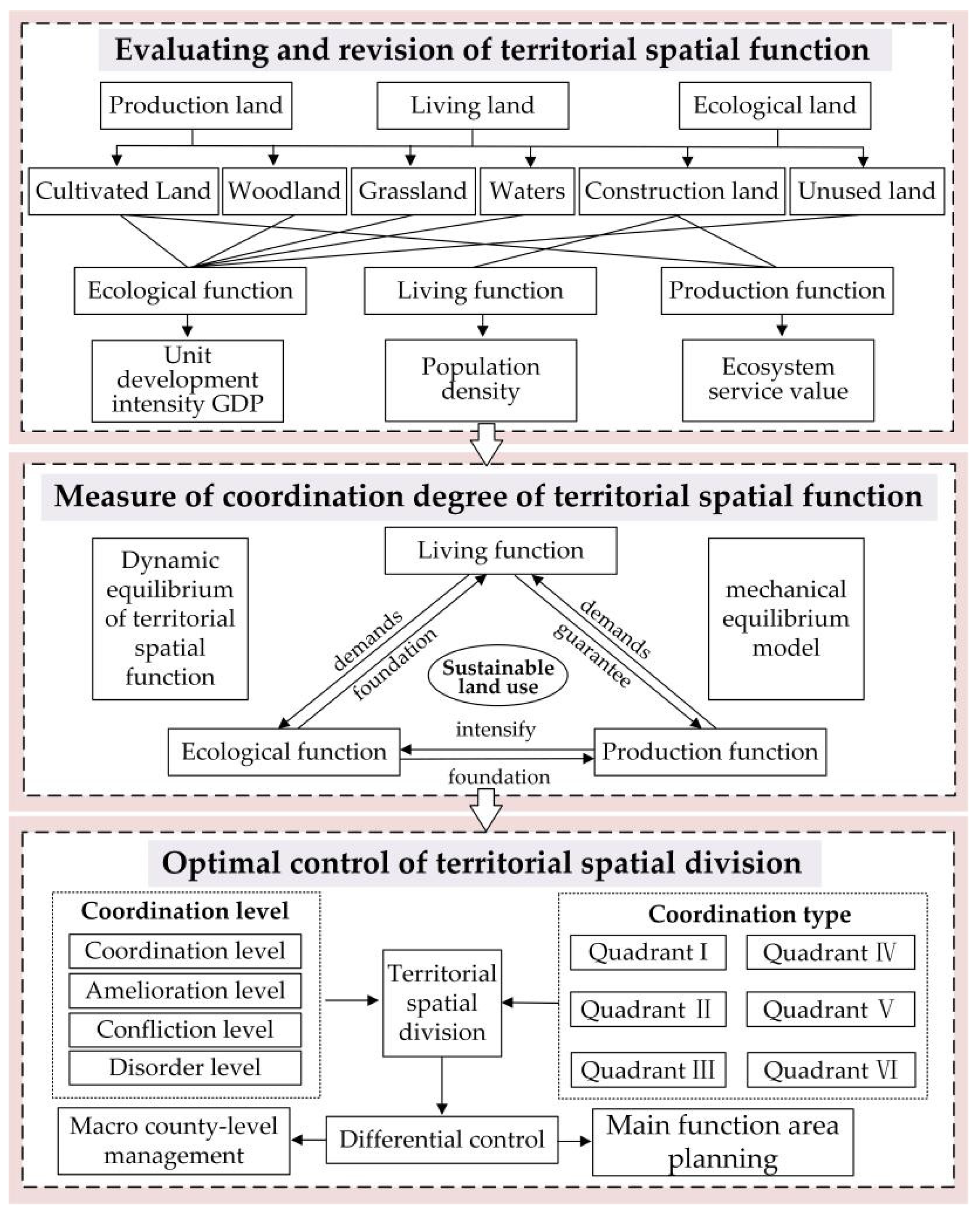
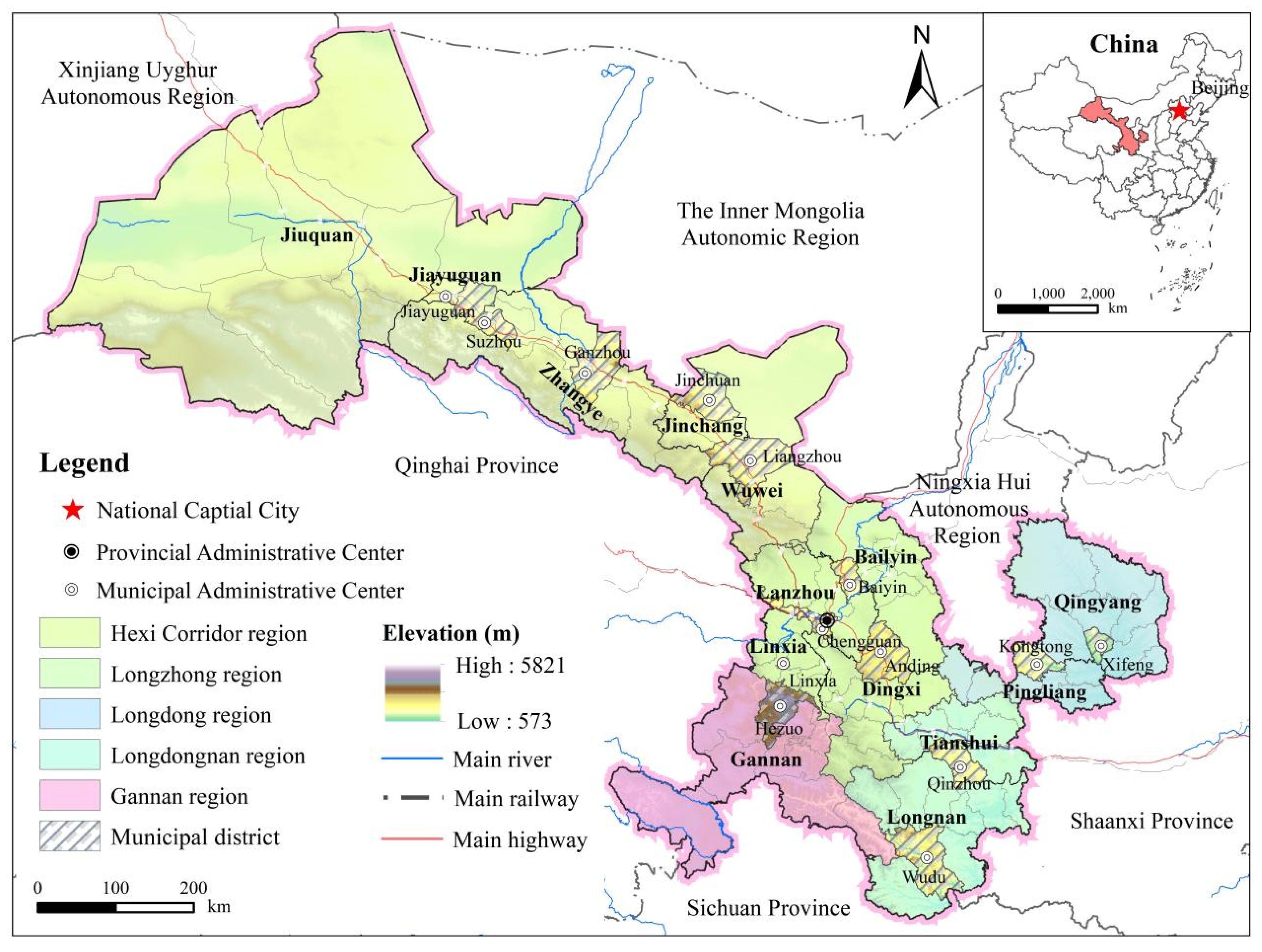
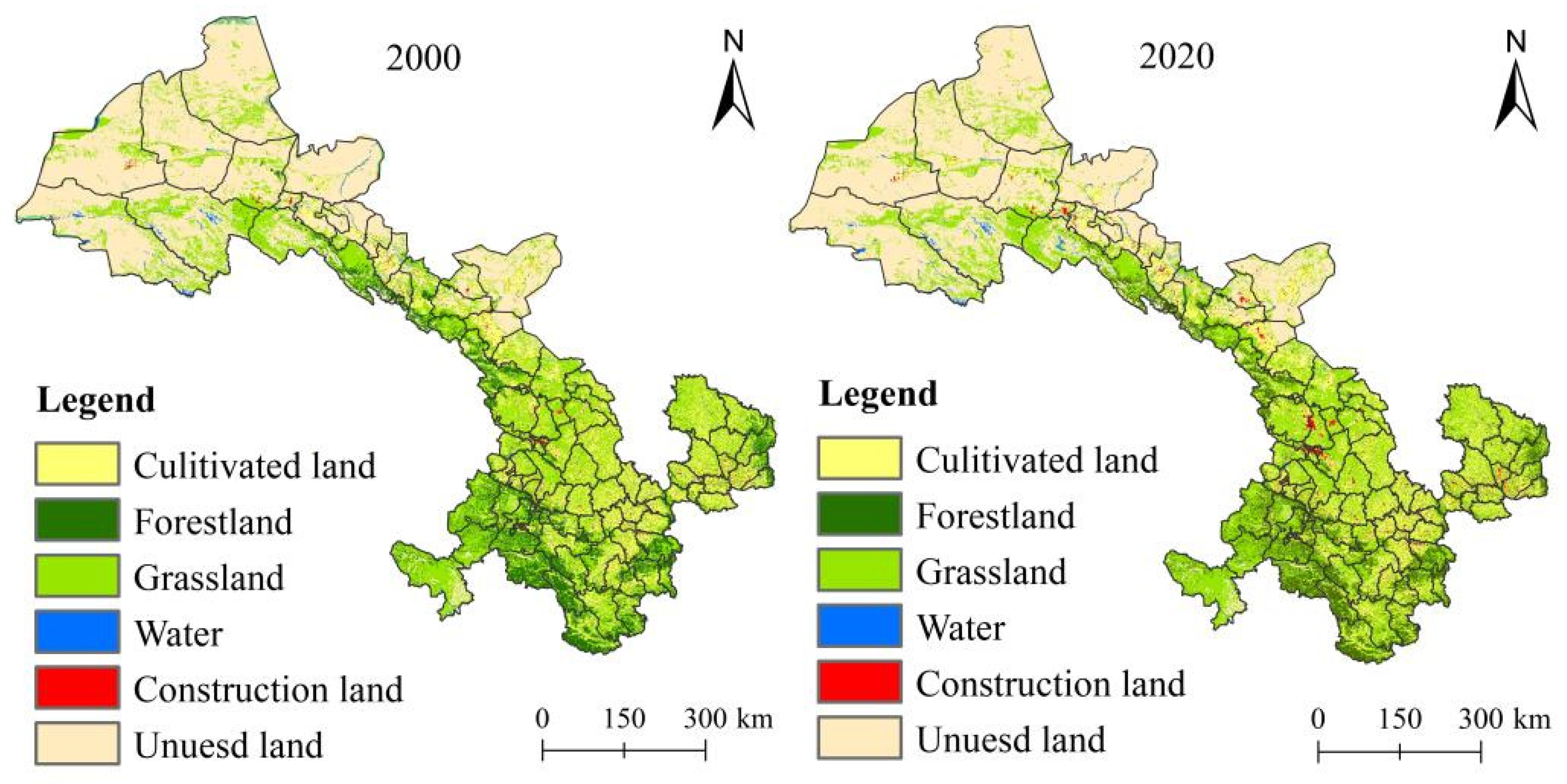

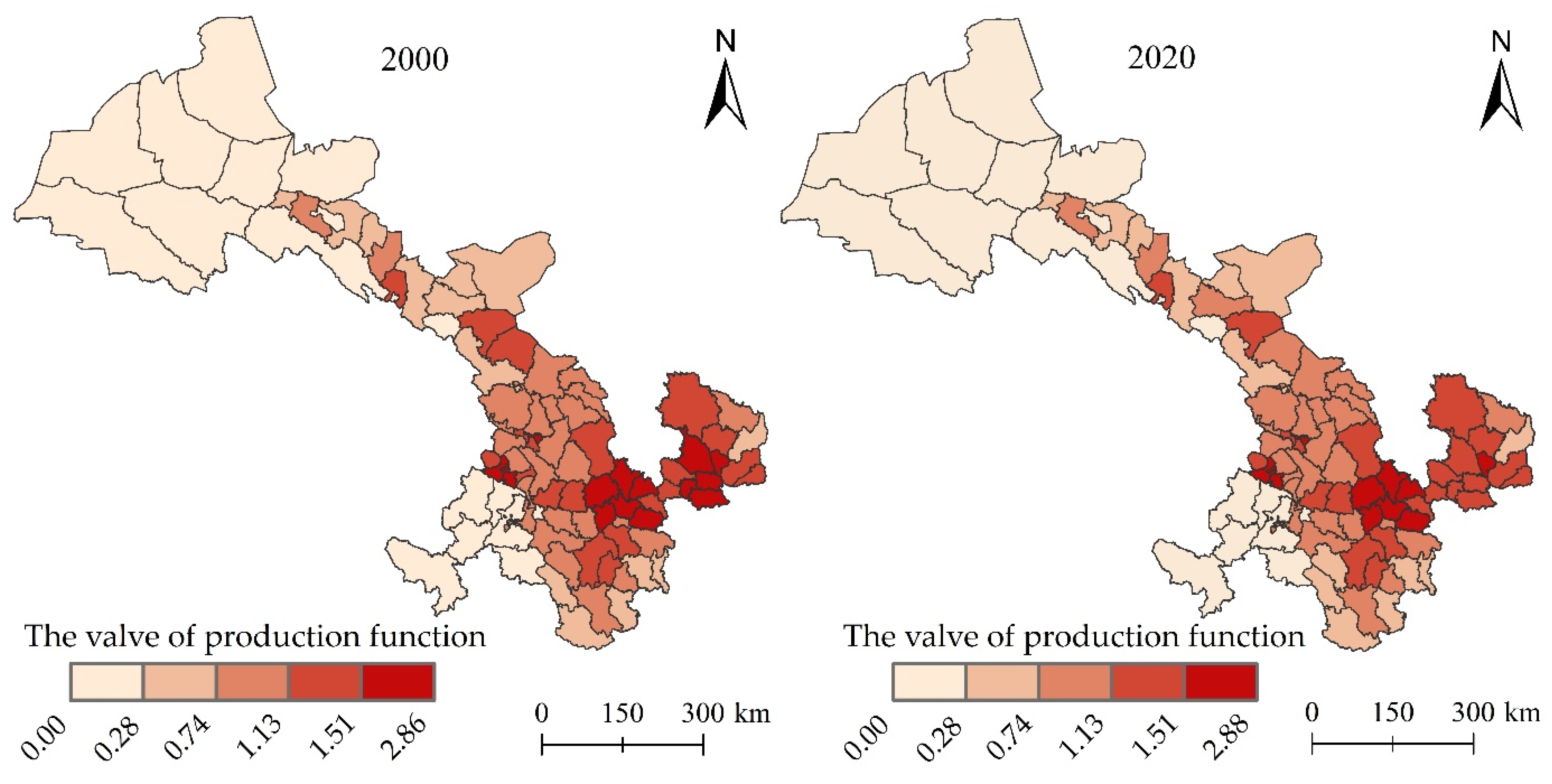
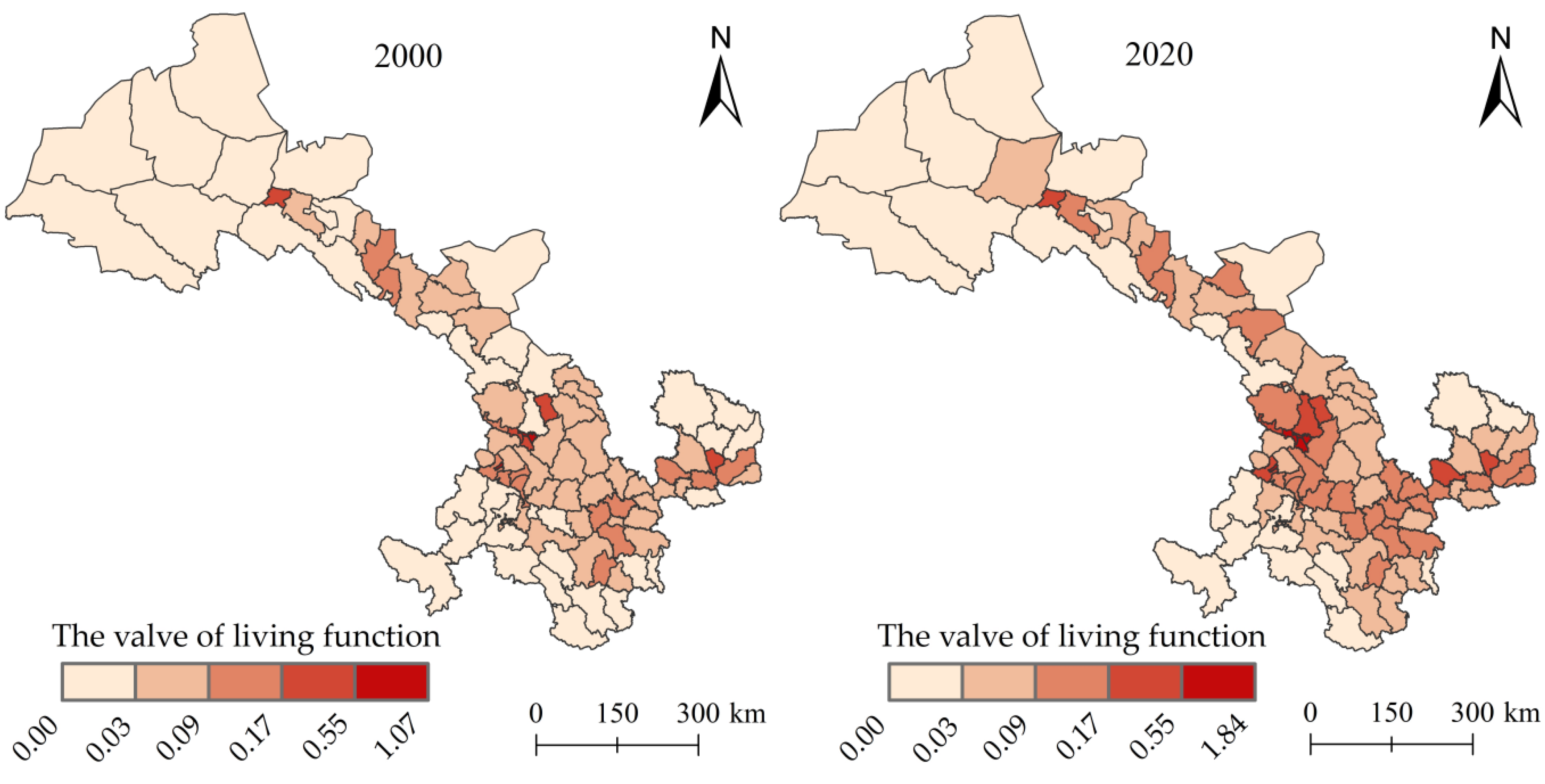
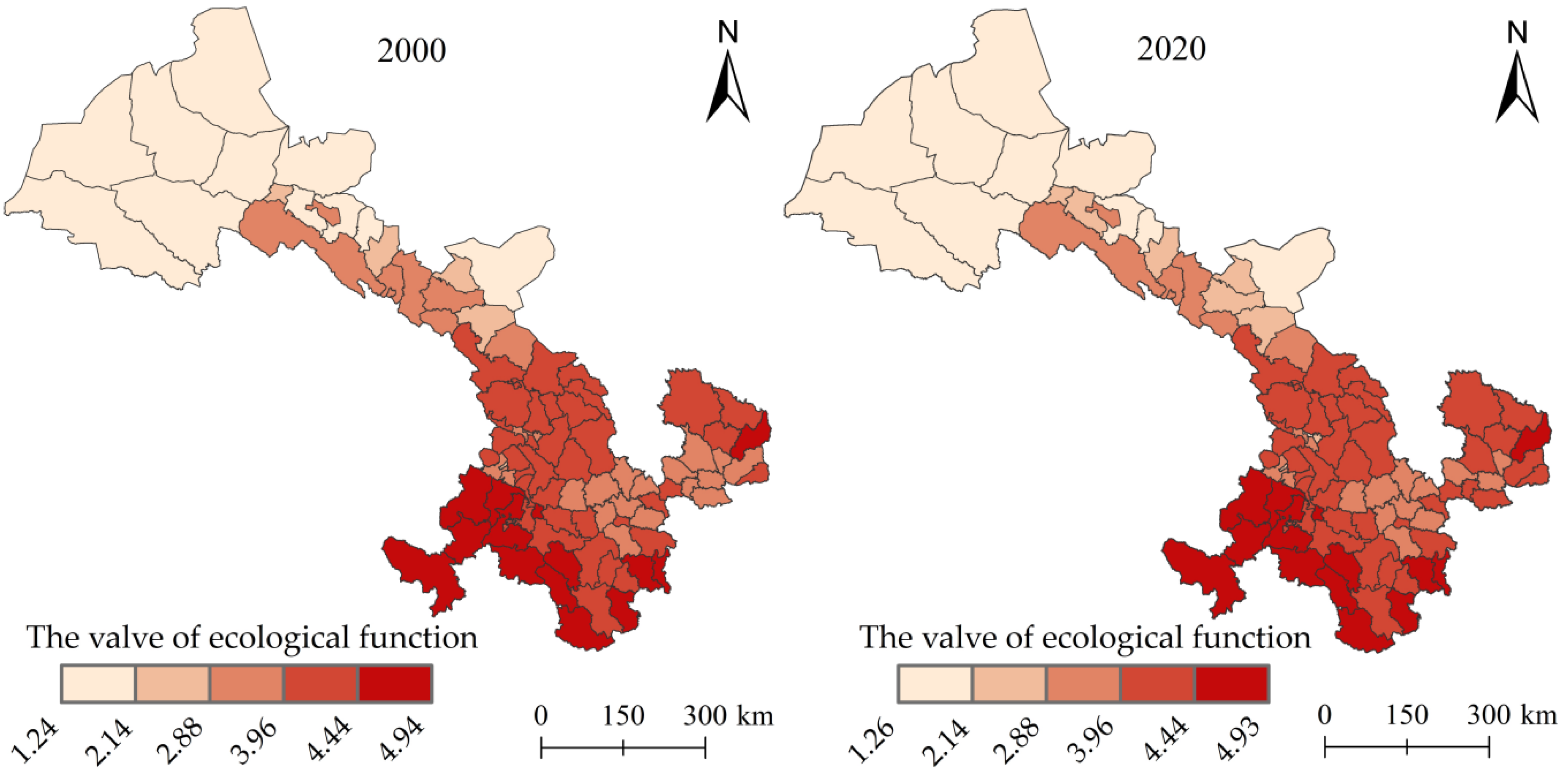
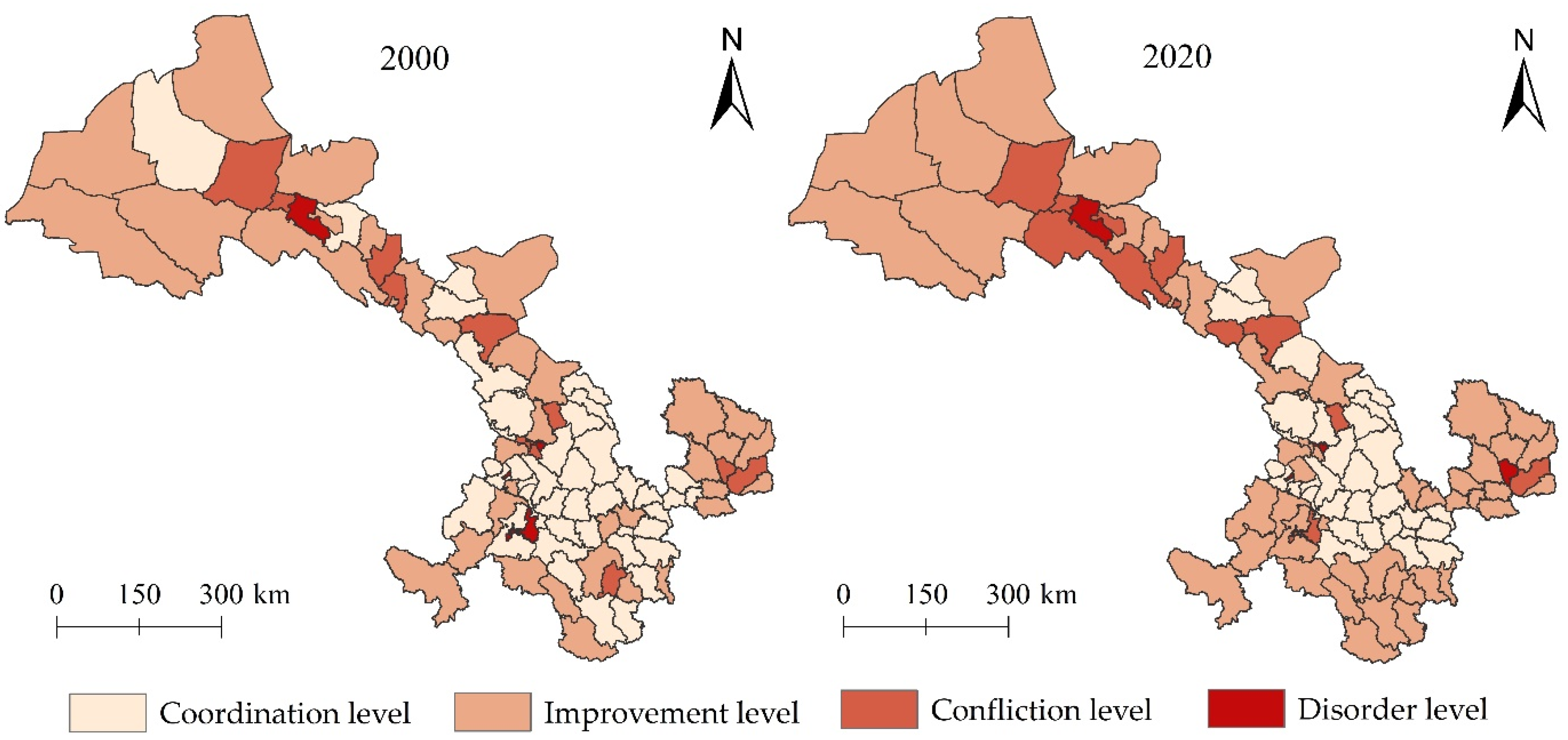

| Function Types | Land Use Types |
|---|---|
| Production function | Paddy field (3), Arid land (3), Other construction land (3), Urban land (5), Rural settlement (3), Closed forest land (0), Shrub forest (0), Sparse forest (0), Other forest lands (0), High coverage grassland (0), Medium coverage grassland (0), Low coverage grassland (0), River channel (3), Lakes (0), Reservoir pit (1), Permanent glacier snow (0), Beach (0), Sandy land (0), Gobi (0), Saline-alkali land (0), Wetlands (0), Bare land (0), Bare rock gravel (0), Others (0) |
| Living function | Paddy field (0), Arid land (0), Other construction land (3), Urban land (5), Rural settlement (5), Closed forest land (0), Shrub forest (0), Sparse forest (0), Other forest lands (0), High coverage grassland (0), Medium coverage grassland (0), Low coverage grassland (0), River channel (0), Lakes (0), Reservoir pit (0), Permanent glacier snow (0), Beach (0), Sandy land (0), Gobi (0), Saline-alkali land (0), Wetlands (0), Bare land (0), Bare rock gravel (0), Others (0) |
| Ecological function | Paddy field (3), Arid land (3), Other construction land (0), Urban land (0), Rural settlement (0), Closed forest land (5), Shrub forest (5), Sparse forest (3), Other forest lands (5), High coverage grassland (5), Medium coverage grassland (5), Low coverage grassland (5), River channel (1), Lakes (5), Reservoir pit (1), Permanent glacier snow (5), Beach (5), Sandy land (1), Gobi (1), Saline-alkali land (1), Wetlands (5), Bare land (1), Bare rock gravel (1), Others (1) |
| Quadrant | Angel | Force Characteristics | Characteristic Description | ||
|---|---|---|---|---|---|
| LF | EF | PF | |||
| I | [11π/6, 0], [0, π/6] | ± | − | + | The production function is higher than the established standard value, and the ecological function is lower than the established standard value. The direction of the force of the living function is both positive and negative. |
| II | [π/6, π/2] | + | − | ± | The living function is higher than the established standard value, and the ecological function is lower than the established standard value. The direction of the force of the production function is both positive and negative. |
| III | [π/2, 5π/6] | + | ± | − | The living function is higher than the established standard value, and the production function is lower than the established standard value. The direction of the force of ecological function is both positive and negative. |
| IV | [5π/6, 7π/6] | ± | + | − | The ecological function is higher than the established standard value, and the production function is lower than the established standard value. The direction of the force of the living function is both positive and negative. |
| V | [7π/6, 3π/2] | − | + | ± | The ecological function is higher than the established standard value, and the life function is lower than the established standard value. The direction of the force of the production function is both positive and negative. |
| VI | [3π/2, 11π/6] | − | ± | + | The production function is higher than the established standard value, and the living function is lower than the established standard value. The direction of the ecological function force is both positive and negative. |
| Function Zones | Representative Zones | Optimization Strategy |
|---|---|---|
| Production function dominant (living function and ecological function improvement zones) | Lanzhou-Baiyin, Jiuquan-Jiayuguan, Ganzhou-Linze, Jinchang-Wuwei, Pingliang-Qingyang municipal district Tiancheng (Tianshui-Chengxian, Huixian) area | Optimize urban land use structure and increase ecological land supply Fully tap the potential of the existing land use in the city, and promote the economical and intensive use of construction land Persist in ecological protection, increase the supply of public services and optimize the industrial structure |
| Living function dominant (production function and ecological function improvement zones) | Agricultural Industrial Belt along the Yellow River (Linxia City, Yongjing County, etc.) Main production areas of Hexi agricultural products (Gaotai County, Guazhou County, etc.) Main production areas of Longdong agricultural products (Heshui County, Chongxin County, etc.) | Increase ecological land and enhance ecological functions Optimize the layout of living space and ecological space, and improve the overall ecological environment within the region |
| Ecological function dominant (living function and production function improvement zones) | Important water supply ecological function areas of the Yellow River in Gannan (Xiahe County, Kangle County, etc.) Qilian Mountain Glacier and Water Conservation Ecological Function Zones (Subei County, Shandan County, Gulang County, etc.) | According to the characteristics of regional natural resources, develop characteristic industries, such as tourism and rural tourism industry Continuously improve the public infrastructure conditions in the region, improve the quality of life of residents and enhance regional production functions |
Publisher’s Note: MDPI stays neutral with regard to jurisdictional claims in published maps and institutional affiliations. |
© 2022 by the authors. Licensee MDPI, Basel, Switzerland. This article is an open access article distributed under the terms and conditions of the Creative Commons Attribution (CC BY) license (https://creativecommons.org/licenses/by/4.0/).
Share and Cite
Xie, B.; Wang, Q.; Huang, B.; Chen, Y.; Yang, J.; Qi, P. Coordinated State Analysis and Differential Regulation of Territorial Spatial Functions in Underdeveloped Regions: A Case Study of Gansu Province, China. Sustainability 2022, 14, 950. https://doi.org/10.3390/su14020950
Xie B, Wang Q, Huang B, Chen Y, Yang J, Qi P. Coordinated State Analysis and Differential Regulation of Territorial Spatial Functions in Underdeveloped Regions: A Case Study of Gansu Province, China. Sustainability. 2022; 14(2):950. https://doi.org/10.3390/su14020950
Chicago/Turabian StyleXie, Baopeng, Quanxi Wang, Beiying Huang, Ying Chen, Jie Yang, and Peixin Qi. 2022. "Coordinated State Analysis and Differential Regulation of Territorial Spatial Functions in Underdeveloped Regions: A Case Study of Gansu Province, China" Sustainability 14, no. 2: 950. https://doi.org/10.3390/su14020950
APA StyleXie, B., Wang, Q., Huang, B., Chen, Y., Yang, J., & Qi, P. (2022). Coordinated State Analysis and Differential Regulation of Territorial Spatial Functions in Underdeveloped Regions: A Case Study of Gansu Province, China. Sustainability, 14(2), 950. https://doi.org/10.3390/su14020950





